
The Miami Circle, also known as The Miami River Circle, Brickell Point, or The Miami Circle at Brickell Point Site, is an archaeological site in Brickell, Miami, Florida. It consists of a perfect circle measuring 38 feet (11.5m) of 600 postmolds that contain 24 holes or basins cut into the limestone bedrock, on a coastal spit of land, surrounded by a large number of other 'minor' holes. It is the only known evidence of a prehistoric permanent structure cut into the bedrock in the Eastern United States, and considerably predates other known permanent settlements on the East Coast. It is believed to have been the location of a structure, built by the Tequesta Indians, in what was possibly their capital. Discovered in 1998, the site is believed to be somewhere between 1,700 and 2,000 years old.
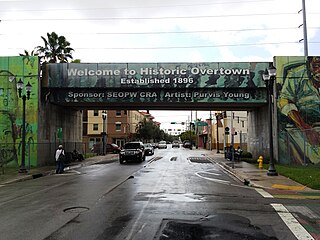
Overtown is a neighborhood of Miami, Florida, United States, just northwest of Downtown Miami. Originally called Colored Town in the Jim Crow era of the late 19th through the mid-20th century, the area was once the preeminent and is the historic center for commerce in the black community in Miami and South Florida.

The Palm Cottage is a historic home in Miami, Florida. It is the last known building in Miami directly associated with railroad magnate and developer Henry M. Flagler. It is also one of the city's few surviving examples of Folk Victorian architecture. Built around 1897, this house was one of at least 30 rental houses that Flagler constructed as homes for the workers building his Royal Palm Hotel. The building was moved to Fort Dallas Park in 1980, located at 60 Southeast 4th Street. On January 4, 1989, it was added to the U.S. National Register of Historic Places.

The Brickell Mausoleum is a historic mausoleum located in Miami, Florida at 501 Brickell Avenue. On January 4, 1989, it was added to the U.S. National Register of Historic Places.

El Jardin is a house located at 3747 Main Highway in Miami, Florida. It is listed on the U.S. National Register of Historic Places. El Jardin is now home to Carrollton School of the Sacred Heart in Miami, Florida. It was added to the U.S. National Register of Historic Places on August 30, 1974.

The First Coconut Grove Schoolhouse is a historic school located in Coconut Grove, Florida. The school originally resided at 2916 Grand Avenue in Miami. The structure was built in 1887 by Coconut Grove pioneer Charles Peacock. Peacock reportedly constructed the house using wood gathered from ships wrecked in nearby Key Biscayne. The building originally served as a community gathering place, with Sunday School as its main purpose.
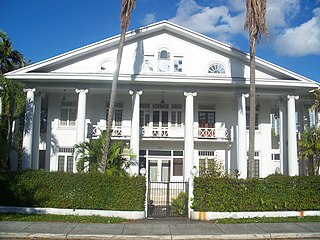
The J. W. Warner House is a historic home in Miami, Florida. It is located at 111 Southwest 5th Avenue. On June 1, 1983, it was added to the U.S. National Register of Historic Places.
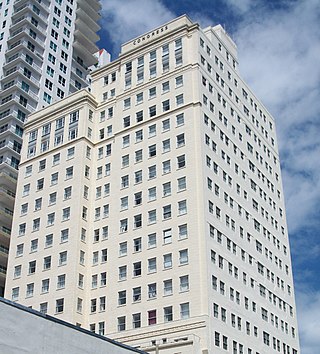
The Congress Building, or simply the Congress Building, is a historic skyscraper in Downtown Miami, Florida, United States. It is located at the address of 111 Northeast 2nd Avenue. The Congress Building was added to the National Register of Historic Places on March 14, 1985, and is locally identified a historic site in the Downtown Miami Development of Regional Impact (DRI). The Congress Building was formerly office space until 1999, when it was restored and converted to apartments. At street level, the building contains retail space which is leased to a number of stores and services including a financial establishment, The Loft condo sales center, beauty salon and café. Originally the building was five stories; the additional 16 were added on later.

The Hahn Building is a historic site in Miami, Florida, United States. It is located at 140 Northeast 1st Avenue. On January 4, 1989, it was added to the U.S. National Register of Historic Places.

The Huntington Building is a historic site in Miami, Florida. It is located at 168 Southeast 1st Street. On January 4, 1989, it was added to the U.S. National Register of Historic Places.
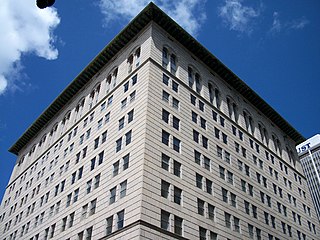
The Ingraham Building is a historic site in Miami, Florida. The location of the Ingraham Building is at 25 Southeast 2nd Avenue. On January 4, 1989, it was added to the U.S. National Register of Historic Places.

The Halissee Hall is a historic site in Miami, Florida. It is located at 1475 NW 12th Avenue. On October 1, 1974, it was added to the U.S. National Register of Historic Places.

The S & S Sandwich Shop is a historic site in Miami, Florida. It is located at 1757 Northeast 2nd Avenue. On January 4, 1989, it was added to the U.S. National Register of Historic Places.

The Dr. James Madison Jackson Office is a historic site in Miami, Florida. It is located at 190 Southeast 12th Terrace. The first resident physician of Miami, Dr. James M. Jackson, had his office and surgery in this building. More recently, it became the offices of the Dade Heritage Trust. On February 24, 1975, the structure was added to the U.S. National Register of Historic Places. The building is located in the center of Brickell, near Downtown Miami. A great nephew, James Madison Barco, is named for Dr. Jackson.

The City National Bank Building is a historic bank building in Miami, Florida. It is located at 121 Southeast 1st Street. On January 4, 1989, it was added to the U.S. National Register of Historic Places. It was built shortly before the 1926 Miami hurricane which ended the early-20s real estate boom in Miami. In 2012 the building was sold and renovated to become a boutique Langford Hotel.

The Fire Station No. 2 is a historic fire station in Miami, Florida. On January 4, 1989, it was added to the U.S. National Register of Historic Places.
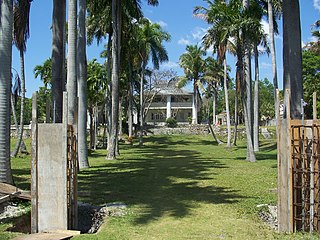
The Trapp Homestead is a historic home in the Coconut Grove section of the City of Miami, Florida, United States. It is located at 2521 South Bayshore Drive. On November 10, 1994, it was added to the U.S. National Register of Historic Places. The home was constructed in 1887 out of oolitic lime quarried locally by Caleb Trapp and his son, Harlan. During construction, the Trapps lived on a thatched hut at the front of the property. The property is believed to be the oldest-standing masonry home in Miami-Dade County, Florida. The estate's construction pre-dates the incorporation of the City of Miami. The estate was particularly notable at the time because it was one of the few stone structures in Miami-Dade County, as nearly all structures in the area were built of wood at that time.

August Geiger was one of the most prominent American architects in South Florida from 1905 to the late 1940s. He experimented in Mission, Neo-Renaissance and Art Deco architecture, but is most noted for his works in the Mediterranean Revival style. A number of his works are listed on the U.S. National Register of Historic Places.

The Health District, also known as the Civic Center, is a neighborhood in the city of Miami, Florida. The Health District is bound roughly by Northwest 20th Street and 14th Avenue to the northwest, the Dolphin Expressway and the Miami River to the south and west, and the Midtown Interchange and I-95 to the east.

Miami City Hall is the local government headquarters for the City of Miami, Florida. It has been located in the former Pan American Airlines Terminal Building on Dinner Key, which was designed by Delano & Aldrich and constructed in 1934 for the former International Pan American Airport, since 1954. The city's government headquarters originated in Downtown Miami for 58 years until its relocation to Coconut Grove.























